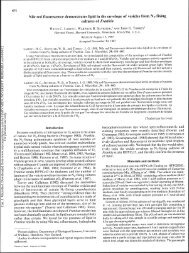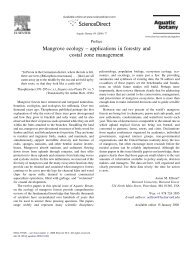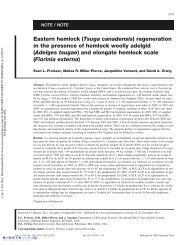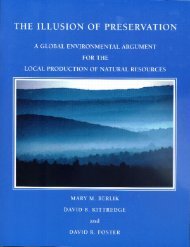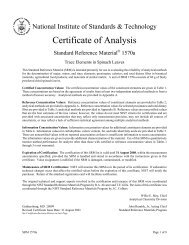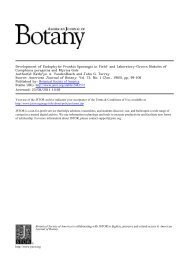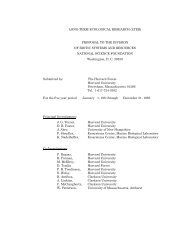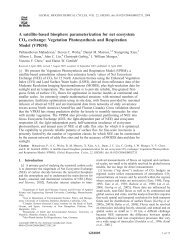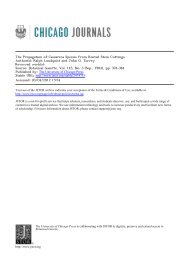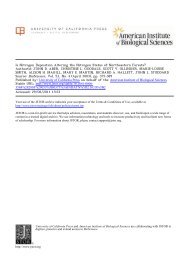Abstracts of Papers - Harvard Forest - Harvard University
Abstracts of Papers - Harvard Forest - Harvard University
Abstracts of Papers - Harvard Forest - Harvard University
Create successful ePaper yourself
Turn your PDF publications into a flip-book with our unique Google optimized e-Paper software.
The sporophyte <strong>of</strong> Leucodon julaceus (Hedw.) Sull. has<br />
a peristome consisting <strong>of</strong> a reduced endostome and an<br />
exostome <strong>of</strong> sixteen stout, pale teeth that are orna-<br />
mented with papillae on the upper two-thirds <strong>of</strong> the<br />
teeth. The endostome is composed <strong>of</strong> cellulosic prim-<br />
ary cell walls <strong>of</strong> the inner (IPL) and primary (PPL)<br />
peristome layers, plus heavy secondary wall thicken-<br />
ings on the IPL which appear to be <strong>of</strong> carbohydrate<br />
and lipid composition. The exostome is composed <strong>of</strong><br />
portions <strong>of</strong> adjacent periclinal cell walls <strong>of</strong> the PPL<br />
and outer (OPL) peristome layers and a common middle<br />
lamella. The middle lamella is composed <strong>of</strong> pectin-<br />
aceous and lipoidal compounds. The adjacent primary<br />
walls <strong>of</strong> the PPL and OPL are composed <strong>of</strong> densely<br />
packed cellulosic micr<strong>of</strong>ibrils. The primary walls<br />
are highly birefrigent and the main axis <strong>of</strong> micro-<br />
fibril orientation is parallel to the longitudinal<br />
axis <strong>of</strong> the tooth. Secondary wall thickenings are<br />
heaviest along the PPL and consist <strong>of</strong> cellulosic<br />
micr<strong>of</strong>ibrils embedded in a matrix <strong>of</strong> other carbohy-<br />
drate and lipoidal compounds. The basal one-third <strong>of</strong><br />
the exostome exhibits the heaviest secondary thicken-<br />
ings on the inner lamellae. The peristome functions<br />
in the regulation <strong>of</strong> spore release and is classified<br />
as hydrocastique because spore release is favored<br />
during periods <strong>of</strong> high humidity). The second-<br />
ary wall thickenings at the base <strong>of</strong> the inner<br />
lamellae <strong>of</strong> the exostome swell upon hydration, caus-<br />
ing the teeth to reflex to an erect position, thus<br />
allowing unhindered release <strong>of</strong> spores from the urn.<br />
Upon dehydration, these thickenings <strong>of</strong> the inner<br />
lamellae shrink causing the teeth to inflex over the<br />
mouth <strong>of</strong> the urn.<br />
OLAFSEN, ASTRID G. * and THOMAS H. NASH III.<br />
Department <strong>of</strong> Botany and Microbiology, Arizona<br />
State <strong>University</strong>, Tempe AZ 85287.<br />
- Patterns in carbon and nitrogen fixation in two<br />
lichens from arctic habitats.<br />
Peltigera canina and Stereocaulon tomentosum, two disparate<br />
nitrogen-fixing species, were monitored diurnally<br />
in situ throughout the summer at Anaktuvuk Pass,<br />
Alaska. Nitrogen fixation showed greter responses to<br />
changes in thallus water content (%oven dry weight)<br />
than did carbon fixation. At thallus water less than<br />
250% (P. canina) and 160% (S. tomentosum), nitrogen<br />
fixation declined, almost ceasing at 100%, in contrast<br />
to carbon fixation, which began dropping rapidly at<br />
100% for both species. Above 250% and 160%, nitrogen<br />
fixation increased gradually, peaking at 300% and 200%<br />
for P. canina and S. tomentosum, respectively. Carbon<br />
fixation plateaued at water greater than 100% for both<br />
species, with no decline at high water contents, which<br />
never exceeded 520% for P. canina nor 350% for S. tomentosum.<br />
Nitrogen fixation increased with temperature,<br />
both species having their highest activity (15 nmoles<br />
C2H4 mg-lhr-l (P. c.) and 4.2 nmoles C 2H4 mg-lhr-l<br />
(S. t.)) recorded at 19-21? C, while any photosynthetic<br />
increase with temperature was indistinguisable<br />
from the light effect. Gross photosynthesis saturated<br />
at 260-320 ,uE (.28 cal cm 2min 1) for P. canina, and<br />
100 ,uE higher for S. tomentosum, with nightime fixation<br />
5-10% <strong>of</strong> daytime levels; nightime nitrogen fixation<br />
continued on par with daytime levels, showing no<br />
increase with increased light. Since 90% <strong>of</strong> the observed<br />
light levels and 80% <strong>of</strong> the observed temperatures<br />
<strong>of</strong> physiologically active samples were at or below<br />
these optima,<br />
photosynthesis<br />
both species were light<br />
and temperature limited<br />
limited for<br />
for nitrogen<br />
fixation through most <strong>of</strong> the season.<br />
Bryological and Lichenological Section 7<br />
RUSHING, ANN E.*, ZANE B. CAROTHERS AND JEFFREY G.<br />
DUCKETT. Department <strong>of</strong> Botany, <strong>University</strong> <strong>of</strong><br />
Illinois, Urbana, IL 61801 and School <strong>of</strong> Biological<br />
Sciences, Queen Mary College, Mile End Road, London<br />
El 4NS. U.K. Some aspects <strong>of</strong> spermatid microanatomy<br />
in the Jungermanniales.<br />
A comparative study <strong>of</strong> the locomotory apparatus and<br />
cytoskeleton <strong>of</strong> Cephalozia lunulifolia and Chiloscyphus<br />
pallescens (Jungermanniales) has revealed numerous<br />
similarities between these two species and notable<br />
differences from previously investigated hepatics.<br />
In both species, the spermatid mother cells undergo<br />
ovalization prior to the final mitotic division, and<br />
the multilayered structure (MLS) shows the typical<br />
4-layered morphology. In Cephalozia, the anterior<br />
portion <strong>of</strong> the lamellar strip (LS) is wider on both<br />
sides than the narrow anterior portion <strong>of</strong> the spline<br />
but is equal in width to the sDline at its maximum.<br />
Similar lateral extensions <strong>of</strong> the LS were not observed<br />
in Chiloscyphus. At its widest, the spline<br />
<strong>of</strong> Cephalozia comprises 17 microtubles while that <strong>of</strong><br />
Chiloscyphus comprises 25. The spline narrows gradually<br />
to form a shank usually made up <strong>of</strong> 6 long<br />
tubules. The anterior basal body (ABB) occupies a<br />
subapical position; the triplet extensions <strong>of</strong> the<br />
posterior basal body (PBB) extend forward and overlap<br />
with the ABB. The anterior mitochondrion (AM)<br />
follows closely the outline <strong>of</strong> the LS and may extend<br />
posteriorly beyond the LS where it then underlies<br />
the spline. The posterior mitochondrion, in certain<br />
sections, is seen to nearly ensheath the spherical,<br />
starch-containing plastid, a condition more commonly<br />
seen in mosses. The starch grains show a clumped<br />
arrangement. In contrast, the spermatids <strong>of</strong> Marsupella,<br />
the only other jungermannialian genus to be<br />
studied in detail, show no overlap <strong>of</strong> the ABB and the<br />
PBB or their extensions and the starch grains are<br />
linearly arranged in the plastid.<br />
SCHAFFER, KAREN L. Department <strong>of</strong> Botany,<br />
<strong>University</strong> <strong>of</strong> Iowa, Iowa City, IA 52242.<br />
- Development <strong>of</strong> papillae on stem leaves <strong>of</strong><br />
Thuidium delicatulum (Hedw.)BSG.<br />
The development <strong>of</strong> papillae on upper cells <strong>of</strong> stem<br />
leaves <strong>of</strong> Thuidium delicatulum was investigated with<br />
light, scanning and transmission electron microscopy.<br />
Initially, through a combination <strong>of</strong> cell wall depo-<br />
sition and expansion, a small protuberance forms in<br />
the central portion <strong>of</strong> the cell wall. At this point<br />
the cell wall is very thin, but inner and outer<br />
layers are differentiated. The protoplast extends<br />
into the lumen <strong>of</strong> the developing papilla. As a<br />
result <strong>of</strong> further deposition <strong>of</strong> inner cell wall<br />
material, the papilla continues to enlarge and there<br />
is a progressive thickening <strong>of</strong> the entire cell wall.<br />
Associated with this stage is the occurrence <strong>of</strong><br />
tubular vesicles that originate inside the proto-<br />
plast and possibly contain wall precursor material.<br />
These vesicles are closely associated with the<br />
plasmalemma. Also, micr<strong>of</strong>ibril formation has been<br />
observed on the side <strong>of</strong> the plasmalemma adjacent to<br />
the cell wall. Ultimately, the papillae are more-<br />
or-less solid structures that are composed primarily<br />
<strong>of</strong> inner wall material. Although the papillae that<br />
occur on mature stem leaf cells <strong>of</strong> Thuidium<br />
delicatulum are simple, the developmental stages are<br />
fundmentally the same as those that have been es-<br />
tablished previously for the branched papillae<br />
that characterize upper leaf cells <strong>of</strong> Anomodon<br />
attenuatus (Hedw.) Hub.




